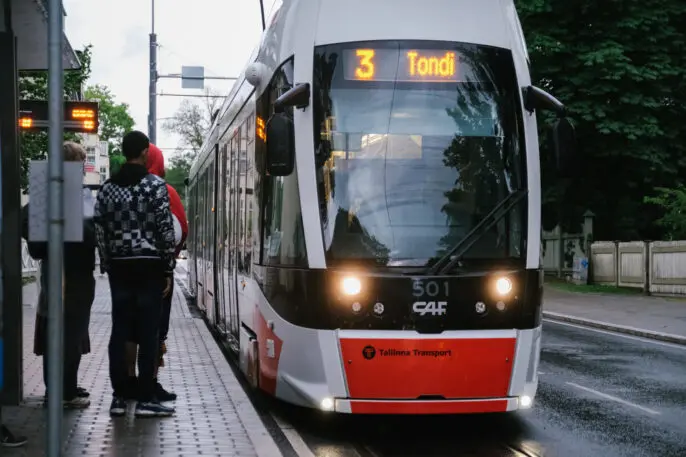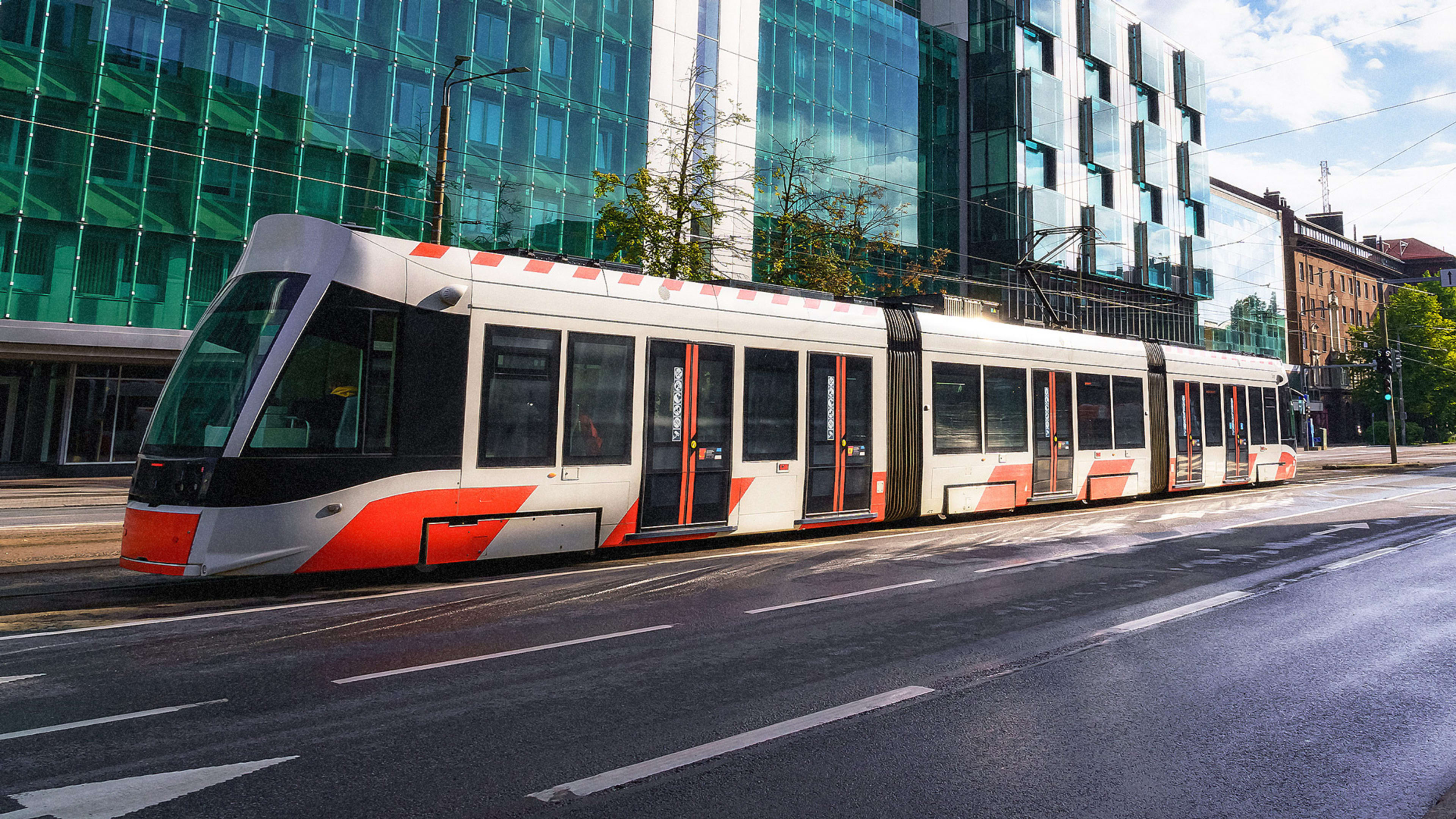From the District of Columbia to San Francisco, a growing chorus of U.S. city leaders are calling on transit agencies to stop collecting fares. Making public transportation free, the argument goes, would provide two key benefits: It would offer a lift to poorer residents (because they ride more often and spend more of their income doing so), and it would lower emissions by reducing driving. Advocates have chalked up a number of wins: Kansas City stopped collecting fares in 2019, while Raleigh did the same a year later. Boston and New York City, two of the most populous and transit-rich regions, are now experimenting with free bus service.
But American cities are not the first movers. A full decade ago, the Estonian capital of Tallinn invited its 426,000 residents to use buses, trains, and trams without paying a cent.

A few weeks ago, I visited Tallinn, where I rode public transportation and met with local mobility leaders inside the city’s medieval old town. I wanted to understand how 10 years of fare-free transit have altered Tallinn’s mobility habits and what lessons the city might hold for leaders elsewhere.
What I learned: Going fare-free has accomplished little in Tallinn. Transit’s share of local commutes has fallen steadily over the past decade, particularly among those with low incomes. Residents today own more automobiles and are more likely to drive than ever before.
“It’s been a relatively useless policy,” Mari Jussi, a sustainable mobility advisor to the Estonian Transport Administration, told me in a café on a windswept cobblestone street. “People here are still shifting to cars.”
To understand Tallinn’s fare-free move, it helps to be familiar with Estonian history and urban planning. After World War II, Estonia was, for decades, a republic within the Soviet Union. During that communist era, massive apartment blocks were built for working-class residents in the urban periphery, often several kilometers away from the center city. Since cars were a luxury, many of those living in those Soviet blocks relied on transit to bring them to and from manufacturing jobs elsewhere in the city.

After gaining independence only in 1991, Estonia was a young country in 2013 when Tallinn’s leaders decided to eliminate fares for residents who take buses, trams, and commuter trains within the city. Because nonresidents would still have to pay, Tallinn’s leaders hoped that the move would compel more Estonians to establish Tallinn as their home city, which would increase local tax revenues.
Another goal related to equity. “Back then, we were still struggling with recovering from the financial crisis that struck in 2008,” Vladimir Svet, Tallinn’s deputy mayor, told me. Allowing residents to ride buses and trams for free could be helpful to those with low incomes (who often lived in those old Soviet blocks and relied on buses and trams). “[Eliminating fares] was seen as a social measure,” Svet said. “The city wanted to ensure that usage of public transport would not fall because of its price.”
But Jussi said that was not a serious risk, because transit was already affordable (monthly transit passes at the time cost around 20 euros, and children as well those 65+ could ride for free). Rather, she believes the move was intended to curry political support. “Fare-free transit didn’t come from a strategic planning process,” she told me. “It was really a vision from politicians to get reelected.” (In the United States, too, elected leaders have been notably more enthusiastic about fare-free transit than transportation experts.)
Shifting trips from cars toward transit, a central goal in today’s fare-free discourse, was only a secondary consideration in Tallinn’s original decision, according to several sources. “At that time, the argument of reducing car usage was not that important,” Svet told me, though he said he now hears about it frequently as climate change worries have grown.
Today, Tallinn is, by all appearances, flourishing. Estonia’s GDP grew almost 50% between 2013 and 2021, and its capital now brims with pricey boutiques and sophisticated restaurants catering to locals as well as hordes of visiting tourists.
Tallinn’s transit system is impressive, especially for a city with fewer than half a million inhabitants. Dedicated lanes speed up many bus and tram trips, and service is stunningly frequent by American standards (streetcars arrived every four minutes on one route I used). Although visitors like me must tap their smartphone or bank card to pay the two-euro fare, Tallinn residents can access the city’s transit network at no cost whenever they like.
Even so, a growing number of locals have chosen to drive instead. According to the Estonian government, transit’s share of Tallinn commutes has fallen from over 40% in 2013, the year fares were eliminated for residents, to under 30% last year. During that time, the proportion of commuters who drove rose from just over 40% to almost 50%.
Notably, transit’s decline has been most pronounced among city residents with the least money. Transit use among those in the bottom quartile of income distribution plummeted from over 60% of commutes in 2013 to around 35% in 2022. Meanwhile, their car use surged: In 2013, less than a fifth of low-income residents drove to work; by 2022 that share had more than doubled.
In other words, Tallinn’s move to eliminate fares has not prevented a stampede away from transit in favor of the automobile, particularly among the poor residents who were envisioned as the policy’s greatest beneficiaries. In 2021, the National Audit Office of Estonia bluntly concluded that Tallinn’s elimination of fares had not reduced driving. (City officials told me they didn’t know how many people may have changed their place of residence to access Tallinn’s offer of free transit.)
The local leaders I met offered several explanations for the underwhelming response to free fares. The first is that Estonia’s growing wealth prompted a surge of car purchases and reduced residents’ desire to ride even free buses and trams. Economists often cite transit as an example of an inferior good: a product that holds less appeal when people become wealthier (as was certainly the case in Estonia during the past decade). Automobiles, on the other hand, are often prized possessions for those whose income has risen. Estonians in 2021 owned 621 cars for every 1,000 people, an increase of 12.5% from 2017 and more than all but four other European Union countries.
Estonian preferences may have played a role as well. Grigori Parfjonov, an urban mobility expert at Tallinn’s transportation department, told me that newly affluent Estonians often purchase a suburban home or a forest cabin. “The best home for an Estonian is one where you go on the roof and you don’t see any neighbors,” he told me. Such places often require a car to access them.
Another factor has been the migration of Tallinn’s local employment. The city’s public transportation network was designed to whisk people in and out of the city center, but manufacturing jobs have steady relocated toward burgeoning suburbs with inferior transit access, a particular challenge for those commuting from peripheral Soviet blocks. Such trends aren’t limited to Estonia: UCLA researchers have linked the suburbanization of jobs to the recent decline in transit ridership among low-income residents and immigrants in Southern California.
Finally, there’s the question of whether a carrot like free fares can affect transportation choices without concurrent policy sticks that make driving more expensive or annoying. Cambridge University researchers have found that a strategy involving sticks is more likely to induce mode shift than one consisting of carrots alone. Jussi said that if Tallinn truly wants to boost transit ridership, the city should charge drivers the full societal cost of their automobile. “Outside the city center, parking is free,” she told me. “The city should change that.”
But Deputy Mayor Svet said that local leaders’ transportation options are often constrained by the national government. As an example, he said that drivers who block a sidewalk are typically fined just 20 euros, an amount that Estonian policymakers have not increased in a decade despite significant wage growth and inflation. “It’s nonsense,” he told me. “I would change that today If I could.” Unlike countries such as Norway and Denmark, the Estonian government has refrained from creating a tax on car purchases, which would make transit more competitive.
Although transit’s share of total Tallinn trips has fallen sharply, the absolute number of rides has risen (albeit at a much slower rate than driving). It is possible that transit’s modal split would have declined faster without the city’s fare-free policy. But whatever appeal free transit holds, it has clearly failed to prevent a pivot toward cars.
The lessons from Tallinn’s experience are ominous for American advocates of fare-free transit, particularly since Tallinn’s transit service is far superior to most U.S. cities. If providing free rides hasn’t boosted ridership in Tallinn, it’s unclear why it would have a greater impact in a place with longer wait times and fewer dedicated transit lanes.
Indeed, American transit passenger surveys have found that improving service quality—not lowering fares—is the best way to boost rider welfare and attract those who would otherwise drive. That seems to be the case in Tallinn, too. Over the summer, the city made tweaks to improve its bus network, with encouraging early results. Parfjonov told me that the city combined two bus routes into one and added more frequency, moves that quickly led to a 70% surge in ridership. He doesn’t yet know whether the adjustments reduced car trips, but he suspects they have: “I know a lot of people along that route with a car who tell me, ‘Now we finally have a bus that is useful.’”
When I asked Jussi what advice she would offer American policymakers who want to improve transit service, she had a ready answer: “Any extra money should be put toward transit service, and not zero fares,” she replied. “Transit’s price is not a barrier for most people. It’s service quality and speed of the trip.”
Recognize your brand’s excellence by applying to this year’s Brands That Matter Awards before the early-rate deadline, May 3.
